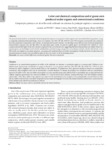Use este identificador para citar ou linkar para este item:
http://www.alice.cnptia.embrapa.br/alice/handle/doc/897618Registro completo de metadados
| Campo DC | Valor | Idioma |
|---|---|---|
| dc.contributor.author | PINHO, L. de | pt_BR |
| dc.contributor.author | PAES, M. C. D. | pt_BR |
| dc.contributor.author | GLÓRIA, M. B. A. | pt_BR |
| dc.contributor.author | ALMEIDA, A. C. | pt_BR |
| dc.contributor.author | COSTA, C. A. | pt_BR |
| dc.date.accessioned | 2011-08-09T11:11:11Z | pt_BR |
| dc.date.accessioned | 2011-08-09T11:11:11Z | pt_BR |
| dc.date.available | 2011-08-09T11:11:11Z | pt_BR |
| dc.date.available | 2011-08-09T11:11:11Z | pt_BR |
| dc.date.created | 2011-08-09 | pt_BR |
| dc.date.issued | 2011 | pt_BR |
| dc.identifier.citation | Ciência e Tecnologia de Alimentos, Campinas, v. 31, n. 2, p. 366-371, abr./jun. 2011. | pt_BR |
| dc.identifier.uri | http://www.alice.cnptia.embrapa.br/alice/handle/doc/897618 | pt_BR |
| dc.description | The present study aimed to evaluate the chemical properties of green corn, grown in both organic and conventional farming systems, using a completely randomized factorial design. Four corn varieties (AG 1051, BR 106, SWB 551 and VIVI) of green corn kernels were evaluated for color, proximate composition, total calories, carotenoids and bioactive amines. The farming system affected some chemical and physical characteristics of green corn, but this effect was dependent upon variety. In general, organic green corn kernels were reddish (a* color component) and had higher levels of ?-carotene compared to the conventional ones, suggesting that these characteristics are related. Moreover, organic green corn had higher levels of total carbohydrates and total energy compared to conventional varieties. On the other hand, crude fiber levels were higher in conventional grains - an unexpected result that deserves further investigation. Finally, the levels of cadaverine and spermine bioactive amines were not affected either by the corn variety or by the farming system. Avaliaram-se as características químicas de milho verde cultivado em sistemas de produção orgânico e convencional. Utilizou-se um delineamento inteiramente casualizado em esquema fatorial 4 × 2, com quatro cultivares (AG 1051, BR 106, SWB 551 e VIVI) em dois sistemas de cultivo (orgânico e convencional), duas ou três repetições. Os parâmetros físico-químicos analisados foram cor, composição centesimal, valor energético total, teor de carotenoides e aminas bioativas. O sistema de produção tem influência sobre as características químicas do milho verde, mas esse efeito é na maioria dos casos específico para cada cultivar. Pode-se generalizar que os grãos advindos de culturas orgânicas apresentam tom mais avermelhado (a*) e maiores teores de β-caroteno, sendo possível que esses dois atributos estejam relacionados. Além disso, milho verde orgânico tem maior teor de carboidratos e teor energético. Em contrapartida, o teor de fibras foi mais alto no cultivo convencional, e esse dado inesperado merece maior investigação. Os teores das aminas bioativas acadaverina e espermina não foram afetados pelo sistema de produção ou cultivar. | pt_BR |
| dc.language.iso | eng | eng |
| dc.rights | openAccess | eng |
| dc.subject | Qualidade nutricional | pt_BR |
| dc.subject | Aminas bioativas | pt_BR |
| dc.subject | Nutritional quality | pt_BR |
| dc.title | Color and chemical composition and of green corn produced under organic and conventional conditions. | pt_BR |
| dc.type | Artigo de periódico | pt_BR |
| dc.date.updated | 2018-05-28T11:11:11Z | pt_BR |
| dc.subject.thesagro | Milho Verde | pt_BR |
| dc.subject.thesagro | Zea Mays | pt_BR |
| riaa.ainfo.id | 897618 | pt_BR |
| riaa.ainfo.lastupdate | 2018-05-28 -03:00:00 | pt_BR |
| dc.identifier.doi | 10.1590/S0101-20612011000200014 | pt_BR |
| dc.contributor.institution | LUCINEIA DE PINHO, UFMG; MARIA CRISTINA DIAS PAES, CNPMS; MARIA BEATRIZ ABREU GLÓRIA, UFMG; ANNA CHRISTINA ALMEIDA, UFMG; CÂNDIDO ALVES COSTA, UFMG. | pt_BR |
| Aparece nas coleções: | Artigo em periódico indexado (CNPMS)  | |
Arquivos associados a este item:
| Arquivo | Descrição | Tamanho | Formato | |
|---|---|---|---|---|
| Colorchemical.pdf | 554,26 kB | Adobe PDF |  Visualizar/Abrir |









